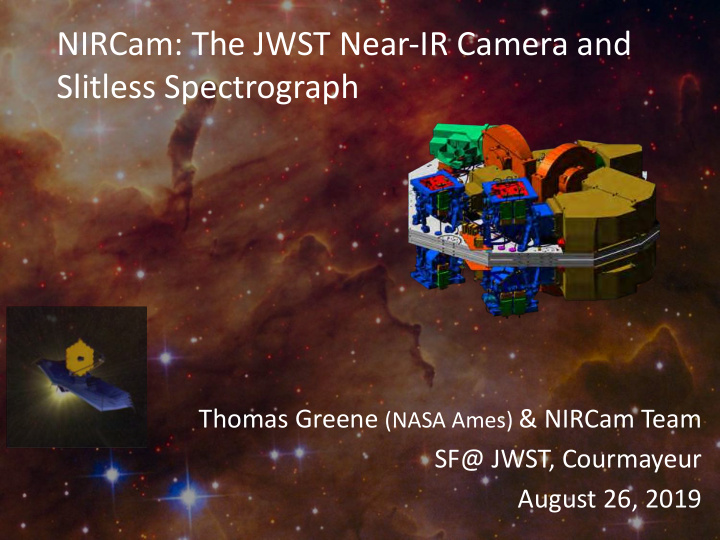



NIRCam: The JWST Near-IR Camera and Slitless Spectrograph Thomas Greene (NASA Ames) & NIRCam Team SF@ JWST, Courmayeur August 26, 2019
Contents NIRCam overview • NIRCam modes • Detectors and Subarrays • Imaging • Coronography and spectroscopy • Star formation GTO programs • Further information • 26 August 2019 2 NIRCam: The JWST Near-IR Camera
NIRCam: 0.6-5 µ m imaging + 2,4-5 µ m spectroscopy NIRCam is the JWST near-infrared camera • for JWST – Two nearly identical modules (A & B) with refractive designs to minimize mass and volume – Dichroic used to split range into short (0.6– 2.3 µ m) and long (2.4–5 µ m) channels – Nyquist sampling at 2 and 4 µ m – 2.2 arc min x 4.4 arc min total field of view seen in two colors (40 MPixels) – Coronagraphic capability for both short and long wavelengths – Dispersive components in short and long channels allow slitless spectroscopy – Led by the University of Arizona (PI M. Rieke) and fabricated by Lockheed Martin NIRCam is also the telescope wavefront • sensor 26 August 2019 NIRCam: The JWST Near-IR Camera 3
NIRCam Science Observing Modes (from Jdox) 4 26 August 2019 NIRCam: The JWST Near-IR Camera 4
NIRCam: Two identical optical modules 26 August 2019 5 NIRCam: The JWST Near-IR Camera
NIRCam and the JWST Focal Plane 26 August 2019 NIRCam: The JWST Near-IR Camera 6
NIRCam Field of View 26 August 2019 NIRCam: The JWST Near-IR Camera 7
Blue and red correspond to the short and long wavelength channels, respectively. The 10 NIRCam detectors (A1–5 and B1–5) are labeled within each module. The coronagraphy field of view, located above the detectors on this plot, is projected onto the detectors when in use (from Jdox). 26 August 2019 NIRCam: The JWST Near-IR Camera 8
NIRCam Detector Readout Modes • Longer exposures group more frames together to conserve data storage and transmission bandwidth 26 August 2019 NIRCam: The JWST Near-IR Camera 9
NIRCam modes: selectable with wheels No Short Wavelength Spectroscopic Capabilities in Cycle 1 0.6 – 2.4 µ m From OTE Simultaneous SW & LW observations are possible (LW) 2,4 – 5 µ m 2 LW grisms in each module provide R~1500 slitless spectroscopy: Chose dispersion orientation and filters to suit your science 26 August 2019 10 NIRCam: The JWST Near-IR Camera
26 August 2019 11 NIRCam: The JWST Near-IR Camera
NIRCam Point-Source Imaging Sensitivity S/N = 10 detection limits for point sources in a 10 ks image (comprised of 10 exposures, 1 ks each). The sources are assumed to have flat spectra in nJy (and AB magnitudes). Zodiacal light is assumed to be 1.2 times the minimum. Filter widths are shown as horizontal bars. 26 August 2019 NIRCam: The JWST Near-IR Camera 12
NIRCam Coronagraphs 26 August 2019 NIRCam: The JWST Near-IR Camera 13
26 August 2019 NIRCam: The JWST Near-IR Camera 14
NIRCam Coronagraphic Pupil Masks Krist+ 2007 SPIE • Coronagraphic throughput is not great 26 August 2019 NIRCam: The JWST Near-IR Camera 15
NIRCam Coronagraphic Performance Roll subtraction (+5 ° and -5 ° ) for speckle suppression. 10 mas position error, 10 nm wavefront error between rolls (Jdox / Beichman+ 2010 PASP) Approx ground-based limit M band (4.7 µ m) for M0V @ 4pc (Krist+ 2007 SPIE) Jdox / Beichman+ 2010 PASP 26 August 2019 NIRCam: The JWST Near-IR Camera 16
NIRCam Si grisms • Provide LW (2.4– 5 µ m) single object and multi- object, wide-field spectroscopy at R > 1000 • Fabricated by D. Jaffe group at U. Texas using Si lithographic techniques (Jaffe+ 2008 SPIE) NIRCam Si grism 26 June 2016 SPIE: NIRCam Spectroscopy 17
NIRCam LW Grism Spectra 2.’2 Increasing l Grism undeviated wavelength is 4.0 µ m * NIRCam FOV is 2.’2 x 2.’2 with dispersion of 10 Å per 0.”065 x 0.”065 pixel * 26 June 2016 SPIE: NIRCam Spectroscopy 18
NIRCam Spectral Coverage & Resolution Greene+ (2018 JATIS 035001-3) 26 August 2019 NIRCam: The JWST Near-IR Camera 19
Spectroscopic Sensitivity 26 August 2019 NIRCam: The JWST Near-IR Camera 20
Star formation example (K Hodapp & L Chu) Greene+ 2017 JATIS 26 August 2019 NIRCam: The JWST Near-IR Camera 21
NIRCam Star Formation GTO Science Making of Stars & Planets: Testing the Standard Model 1) What physical variables determine the shape of the IMF? 2) How do cloud cores collapse to form isolated protostars? 3) What are the initial conditions for planet formation? 4) How do disks evolve to shape their planetary systems? Updated Program: 125 hours 26 August 2019 NIRCam: The JWST Near-IR Camera 22
NIRCam Star Formation GTO Programs • Initial Conditions Massive Star Formation: 18 hr (E. Young) • Evolution of Volatiles in Icy Clouds: 38 hr (K. Hodapp) • End of the IMF & Free-floating Planets: 16 hr (M. Meyer) • Origins of Protostars and Planets: 33 hr (T. Greene & J. Leisenring) • Physics and Chemistry of PDRs: 20 hr (K. Misselt) Strong scientific synergy with the NIRISS (planets in formation and star clusters), MIRI (extinction mapping, protostars, disks, and star formation in local group), NIRSPEC, IDS (star clusters near and far) Teams. 26 August 2019 NIRCam: The JWST Near-IR Camera 23
Further Information • Jdox NIRCam information: https://jwst-docs.stsci.edu/near- infrared-camera • NIRCam Team: http://ircamera.as.arizona.edu/nircam/te_team.php • Astronomer’s Proposal Tool for planning observations: http://www.stsci.edu/hst/proposing/apt • JWST exposure time calculator: https://jwst.etc.stsci.edu • Lots of technical papers: just ask! 26 August 2019 NIRCam: The JWST Near-IR Camera 24
Recommend
More recommend